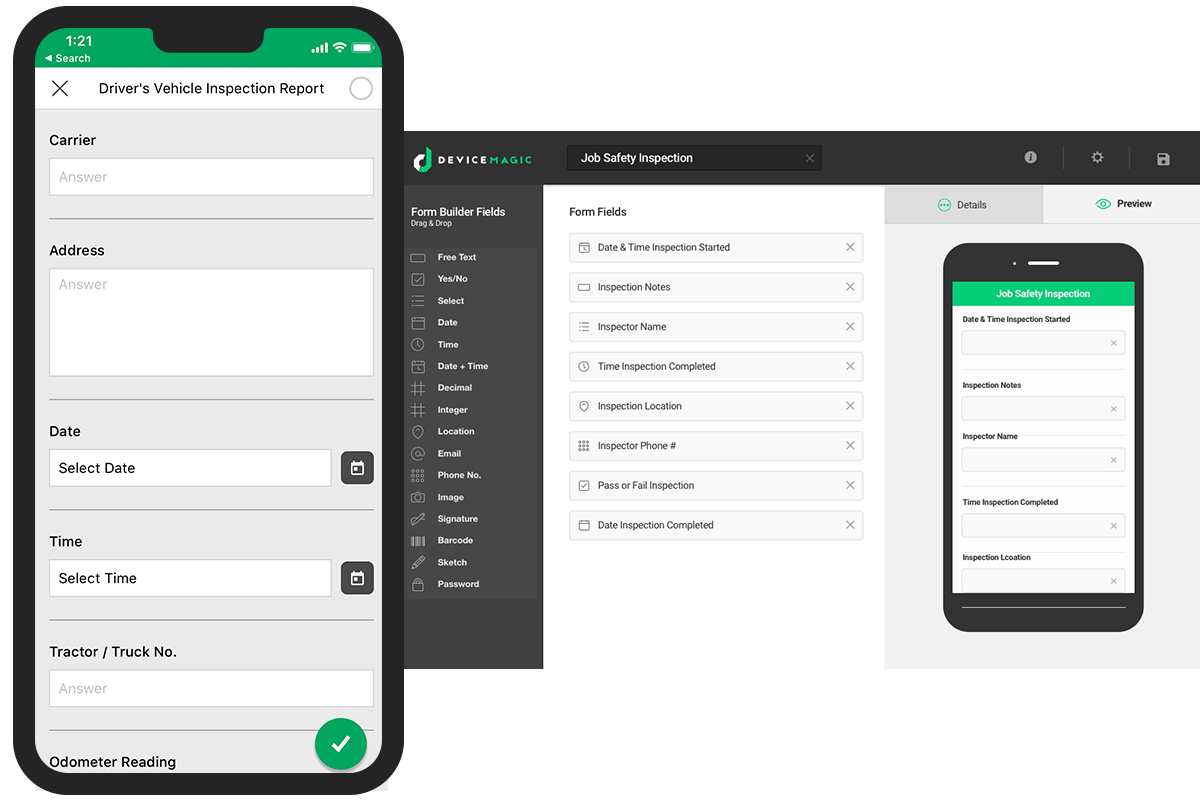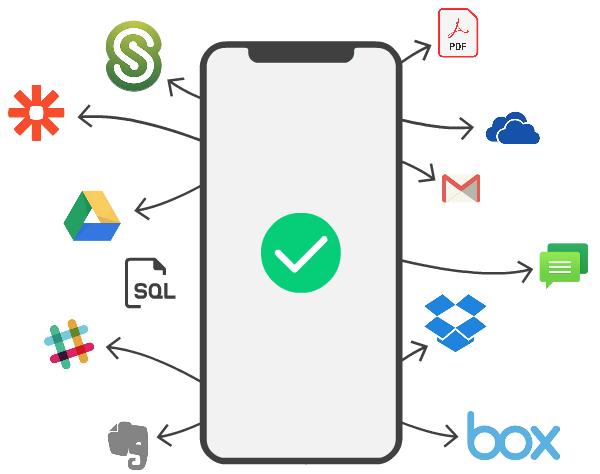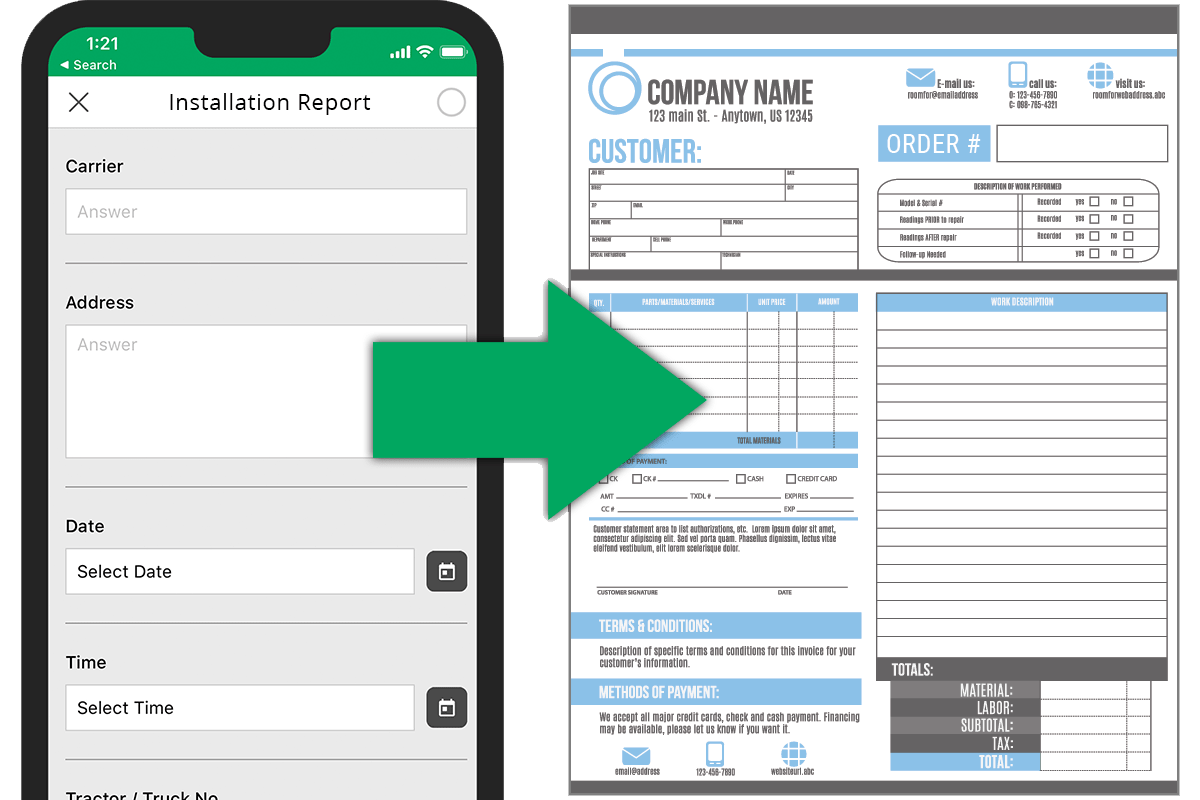Moving to Mobility: The Data Collection Checklist
Moving to Mobility: The Data Collection Checklist

Mobile data collection, while comparable to its punch card and keyboard predecessors, advances the sophistication and flexibility of the data collection process. The nature of today’s mobile devices makes a mobile data collection app far richer, adaptable and extensible than earlier approaches. Unlike a keyboard, which is limited to text inputs and exclusively connected to a single device, a smart phone can accept data in multiple forms.
A mobile data collection device like a smartphone or tablet can create and ingest images, audio and signatures. It can also connect dynamically with a range of applications in multiple hosting scenarios. And, of course, an app for data collection allows the data collector to range far from the site of data processing and storage.
A construction inspector would inspect a building & mark down deviations from construction codes on a paper form. Once completed, the inspector would take the form to an office to have the information keyed into a system.
Now, an inspector can use a mobile form in the field data collection app to input the construction inspection report without the use of pen & paper.
If an inspector needs to take photos, he or she can automatically load images into an inspection record right through the mobile form app interface.
With the mobile data collection app, the inspector can send a completed safety inspection report form instantly back to the central office.
One of the best things about making the move to mobile data capture is the opportunity to make work processes better.
It’s great to replicate existing processes in mobile, but the technology opens up new ways of doing things and can also extend the capabilities of your current solutions. It’s worth examining how a mobile forms and data collection app can help you improve your business operations.

Adding mobile data collection to a workflow exposes places where the process can become more efficient. For example, with conditional questions on forms, it may be possible to capture data more intelligently than was possible before. By implementing this type of logic into your forms, certain questions appear based on answers to the previous questions, removing any questions that might be irrelevant. This makes it faster for the user to complete the form with the required data.
Data collection can also be more dynamic, with real-time interactions with data sources to make the data collected more relevant to the workflow. Businesses that utilize mobile data collection solutions, such as mobile forms apps, have reported gaining access to data sooner, saving administrator hours, and lowering operations costs, among other benefits.

Dashboards and data analytics capabilities give you an understanding of how your data collection is working. You can see activities in real-time and historically. You can track form submissions, monitor critical business functions, identify trends, share actionable insights and more. This way, you will be able to tell how mobile forms are impacting your workflows. If a form or process is slowing things down, you’ll know so you can plan a remedy.

Many enterprise organizations have invested time and resources building their own in-house solutions, which over time become dated and difficult to maintain. These organizations need a flexible and scalable solution that works with and enhances their current tech stack, and is able to fill any gaps. A mobile data capture app can integrate into these industry-specific or legacy systems as a front-end data collection solution.
An integrated solution helps to optimize current workflows and improve the overall data gathering process, resulting in more accurate and timely data.

Many data collection processes end with the production of a PDF document for review by customers or other stakeholders. The PDF creation process is often manual or semi-manual in nature. New mobile data collection technologies are now able to integrate customized PDF production into the workflow. In some cases, it is possible to reproduce the exact look and feel of existing document layouts, including your business logo and other customized elements.
With a mobile data collection app, a PDF can be generated automatically using the collected data and sent to the correct person or location. This removes the step of data collected on a paper form or through another system then needing to be turned into a digital PDF.
Moving to mobile data collection software can be an exciting step forward for your business. It has the potential to streamline business processes and workflows, making your people more productive and increase your bottom line. In our experience, it pays to follow a set of best practice recommendations such as those in this checklist.
Mobile data collection puts you in closer touch with your workflows than other non-mobile techniques. The various drop-offs and disconnects in traditional data collection made it easy to avoid defining precise workflows.
For example, a manual workflow might involve inspecting multiple construction sites, filling out a paper form at each site and then sorting them manually by site. With mobile forms, you can (and should) make the sorting part of the digital workflow.
The best practice is to think through all the ways mobile forms will integrate with business applications and work management tools. Start by mapping out each step of your workflow. Think about what forms you have and what information you need to collect for a particular task, such as a construction site inspection. Once the forms are completed, where or to whom do they need to be sent? Do you need to collect signatures or add images?
Then, with workflows well understood and mapped, it’s possible to execute the integrations necessary for a streamlined mobile data collection process.
Mobile devices offer an opportunity to rethink the structure and contents of data collection forms. It’s a chance to align data collection more closely with business processes. As with workflows, mobile forms reveal hidden, manual processes—for better or worse.
For example, a mobile device used for inventory control can be configured to trigger a purchase order under specified circumstances. The mobile form can also contain questions that drive different business process outcomes.
Before mobile data collection, the business process that went from inventory to purchase order may have contained a number of subjective, manual steps. By replicating these manual steps in the form design and its application integrations, you should be able to make the process more streamlined and efficient.
Making your processes more efficient starts with designing your form for the field data collection app. You have two options when building a mobile form: to replicate your paper form exactly, or to optimize your form for mobile devices and the user.
Use the fact that the form will be completed on a mobile device to your advantage. Include rich data fields such as images or geo-location. Use a multiple select question to allow the user to easily choose all of the answers for a particular question, instead of making them type out each response. You can also easily set rules and expressions for questions to require a certain value or calculate the difference between two answers, and use conditional logic to ask questions based on the answers to previous questions. These features remove unnecessary steps and make the overall form completion process simpler and faster for the user.
Custom mobile forms can be created with a web-based form builder. Simply drag and drop to add, remove, and re-order question fields. Once your form is complete it can be immediately distributed to the appropriate devices.
Mobile devices can add rich media to your form inputs. For instance, you could take a photo of a jobsite or piece of equipment and append it directly to the form in the data collection process. You could also sketch or annotate directly on the image within the form to highlight a part that needs to be replaced or to provide emphasis.
This is a common area where users previously relied on manual processes to collect rich media, and needed to correlate it with business processes and workflows after the fact. By using mobile forms for data collection, you can collect any type of data all within the same form and send it to the correct destination: text fields to a supervisor and images to Dropbox, for example.
The full digital capabilities of the mobile device further expand the field data collection potential. For instance, it is possible to add geo-location data to images and other inputs. This may be useful in cases where regulations require this type of detail (e.g. rules of evidence). Forms can consume barcodes, signatures and other non-text types of data.
Where does your mobile form go when it’s complete? This is known as a “Destination.” In the inventory example above, a paper-based system might involve a clerk dropping a form into a basket for transferal to purchase orders. In turn, the paper purchase order goes into another basket to be picked up by the logistics department for shipment, stocking and so forth.
With mobile forms, delivery of your data is automated. You can specify who gets the form as well as what should happen with the form data. The best mobile data collection solutions will have integrations pre-built with many of the tools and systems your business is using, such as Salesforce, SQL, Dropbox and more. This makes it easy to connect your systems to your mobile forms during the form building process and send data into them directly after a form has been completed, eliminating the need for data re-entry.
Forms automation can also be used to dispatch a form with pre-populated information to an employee off site or a tech in the field. Key details such as a jobsite address or customer information can be pre-filled onto a form before it is sent to an employee’s mobile device. This saves them from having to input the data themselves, and they can focus on completing the rest of the form.
You may need your data to be sent to someone else before it reaches its final destination. Integrating with workflow management solutions, a mobile form can trigger the creation of another mobile form. In the inventory example, the initial inventory report can generate a pre-populated purchase order and logistics form using information from the report that then appears on the mobile device of a delivery driver or stocking clerk. Mobile forms can invoke physical and logical actions through a dispatch feature.
Mobile data capturing offers choices of data delivery formats. It’s a best practice to think through your options as you set up your forms. Choices include text, JPEG, PDF, .DOC, XML, JSON and so forth. The choice will depend on the recipient of the data and what the workflow requires. For instance, if a person will receive the form output, a text- or image-based format is probably ideal.
Alternatively, if the workflow calls for pulling data into a digital process, XML or JSON might be preferable. With today’s wide use of RESTful API for application integration, JSON is becoming more popular than ever as a data delivery format from mobile forms. Using an API allows you to connect to any legacy system you might already be using so that data from mobile forms will easily flow into your back-end systems.
The world is more connected than ever before, but your mobile data collection devices will inevitably venture into places without cellular or WiFi service. You might be underground or far away from a cell tower but data collection must continue. It’s useful to plan for these conditions.
Some apps for mobile data collection enable offline data collection, so be sure to find a field data capture app that offers this functionality. Many dated, industry-specific tools or legacy systems that were built in-house don’t offer this capability. It can be difficult or very costly to update these systems. A mobile forms solution that is fully functional offline can provide the needed link between your frontline employees and back-end systems.
Offline collection should also factor into workflows. Cached data needs to be streamed to the right place when connections do become available without any extra effort needed from the user. Defining user roles and access restrictions can also be useful.
Today’s security threat environment is dangerous and intense. Malicious actors are constantly probing networks looking for points of vulnerability so they can steal data or disrupt operations. Mobile endpoints like smartphones present a double layer of risk exposure. They present a direct risk of data theft if they can be hacked. Additionally, if they are compromised, smartphones offer attackers another point of entry into the corporate network.
To mitigate these risks, the best practice for mobile data collection is to define and implement security controls. Often, these controls and related policies already exist in your organization. However, it may be up to you to implement them. For example, you may want to encrypt form data in transit or establish strict authentication requirements for mobile devices that connect to the network.

